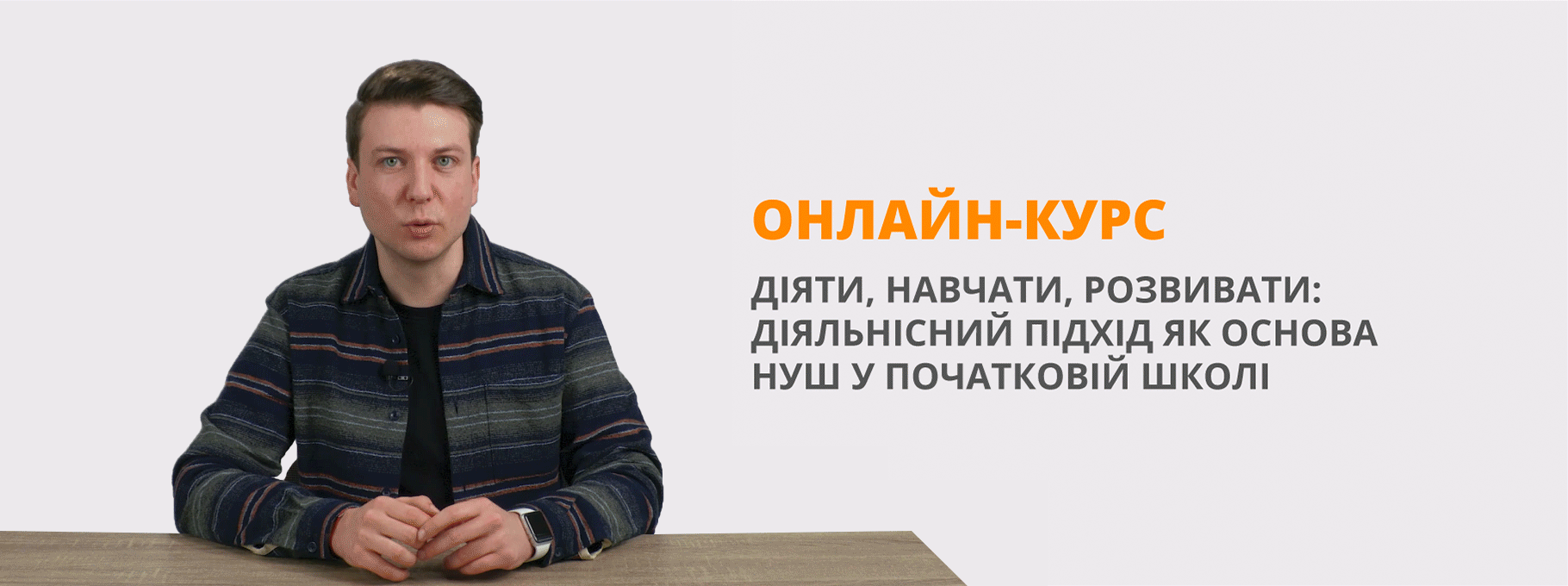Урок "Відомі українські музеї"
Група:___________________Дата:_______________
Тема: Відомі українські музеї
Мета: удосконалювати вміння використовувати українознавчий компонент в усіх видах мовленнєвої діяльності, засобами іноземної мови популяризувати Україну, українську мову, культуру, традиції, критично оцінювати їх, самостійно працювати з підручником, шукати нову інформацію з різних джерел та критично оцінювати її; розвивати сміливість у спілкуванні іноземною мовою, подолання власних мовних бар’єрів, відповідальність за результати навчально-пізнавальної діяльності, наполегливість; виховувати усвідомлення цінності культури для людини і суспільства, повагу до багатства і розмаїття культур, толерантність у спілкуванні з іншими, усвідомлення необхідності володіння іноземними мовами для підвищення власного добробуту.
Тип уроку: розвитку компетентностей
Компетентності: Спілкування державною мовою, Спілкування іноземними мовами, Обізнаність та самовираження у сфері культури, Ініціативність і підприємливість, Уміння вчитися впродовж життя
Обладнання: ілюстративний матеріал, картки для читання, граматичні картки
Хід уроку
- Вступна частина.
- Організація класу. Привітання.
- Повідомлення теми та мети уроку.
think about good ways to work, and bad ways to work. Match the things in the list with sentences 1 and 2. You’ve got three minutes.
1. You’ll probably work best if…
2. You won’t do your best if…
- You are tired or hungry
- You sit in a quiet place
- You revise regularly
- You do a bit of work nearly every day
- You watch TV at the same time
- You ask for help when you need it
- You leave all your revision until the night before a test
- You never do any homework
Have you got any other ideas? Share your ideas with the class. The topic of our lesson is “Museums, exhibitions and galleries in Ukraine”. By the end of the lesson you will be able to understand and use vocabulary on our topic, develop your ability of speaking on the basis of information that you’ve read and hard.
Please, look at the blackboard where the quotation is written: “Life is short, art is long”. I think these words can be the motto of our lesson
- Мовленнєва зарядка. Уведення в іншомовну атмосферу.
Life is short, art is long”. Let’s try to prove that this proverb is really right. What do you think about this quotation? How do you understand these words? Please, start with the words:
I think/I don’t think
I should say…
I am sure…
I agree with/I don’t agree with…
To my mind…
I believe that…
In my opinion…
It seems to me…
No doubt…
I want to add…
- Перевірка домашнього завдання.
- Основна частина.
- Актуалізація опорних знань.
1.2) Grammar Quiz
- Do the Grammar Quiz: choose the correct answer and explain your choice.
- The First Conditional may refer to…
- Present Time
- Future Time
- Past Time
- A, b, and c
- The Second Conditional refers to…
- Future time
- Present time
- either
- neither
- The third conditional refers to…
- present time
- future time
- past time
- a, b and c
- For a real possibility, we use to…
- First Conditional
- Second Conditional
- Third Conditional
- A, b and c
- I’ll tell her if she comes.
- First Conditional
- Second Conditional
- Third Conditional
- Which sentence describes an unreal past event with an unreal present result?
- If I were there, things would be better now.
- If I had been there, things would be better now.
- If I were you, I’d buy this dictionary as soon as possible.
- First Conditional
- Second Conditional
- Third Conditional
- Unless you stop working so late, you’ll never stop being so tired.
- The person should stop working late.
- It’s all right to work late.
- If I had known, I’d have come sooner.
- This is about the present
- This is about the past
- This is about the future
10)If you mix yellow and blue, it makes green.
- This is always true
- This is about the future
- This is about the past.
- Систематизація знань.
2.1)Listening.
1) Pre-listening activity.
- Listen to the text and say where can we get spiritual food?
Vocabulary:
Nourishment – живлення, їжа, пожива (для розуму)
Essential – важливий, істотний
To do an awful lot of sightseeing – оглянути величезну кількість пам’яток
Conducted tour – екскурсія з гідом
Exposition – експозиція музею, виставка
To marvel – захоплюватися
Water-colour – акварель
Separate edition – окреме видання
To deal with – мати відношення до, бути пов’язаним із
To enjoy popularity – користуватися популярністю
2) Listening.
My last visit to the museum.
As the old saying goes man cannot live by bread alone. Any human being needs nourishment for his soul as well. One of the places where one can get spiritual food is a museum. Museums are an essential part of any culture and society.
Last year I went to see a friend who lives in Kyiv. I did an awful lot of sightseeing. I enjoyed my stay there immensely. But what I found absolutely unforgettable was my visit to the Taras Shevchenko Museum.
During the conducted tour I learned much about the museum in general, about the main stages of Ukrainian poet’s life and in the history of our country. The exposition of the museum includes more than 800 works of the great poet and painter and his personal belongings. The most frequently visited are the halls reflecting Shevchenko’s life and work. I marveled at the finest Shevchenko’s water-colours and pencil drawings from the museum’s collection. I found the rare publications of “Kobzar”, Shevchenko’s first book of poetry, and a separate edition of his poem “Haidamaky” the most interesting.
Some of the galleries, which deal with section “Shevchenko and Our Time”, stand out in my memory very vividly: models of monuments to Shevchenko in Ukraine and other countries, the collections of his works in the foreign languages, the vast collection of folk songs, legends and proverbs about the poet, portraits of Shevchenko.
But what is more important, I received an emotional experience. Needless to say, that like any other museum, it should be taken a little at a time. The Taras Shevchenko Museum enjoys a truly universal popularity. I wish I could visit it over and over again.
3.1) Post-listening activity
1. Questions:
- Where can you get spiritual food?
- What does the Taras Shevchenko museum exhibit?
- Had the boy a conducted tour or was alone?
- What is the most frequently?
- What the boy found there, what was the most interesting for him?
- What is saying about sections in the museum?
- What was the more important for the boy after visiting this museum?
2.2) Reading
1) Pre-reading activity
- Read the text and answer the question: how many sections are there and what are they?
2) Reading
Poltava Museum of Local History
The exposition of the Poltava Museum of Local History, which was established in 1891 on the initiative of professor V.V. Dokuchaev, an outstanding specialist in soil science, shows the century-old history of the Poltava region.
The house of the Museum was built in 1902-1908 according to the project by O.I. Shirshov and V.G. Krichevsky for the “gubernia zemstvo”.
In 1920 the central proletarian museum of the Poltava region was opened – one of the first in Ukraine.
The Poltava Museum is one of the largest in Ukraine. Its exposition has over 180000 exhibits including interesting collections and unique items. The exposition is decorated in modern style with a wide use of up-to-date facilities: films, records and playback facilities, diorama and slide projectors. The foundation of the dendropark is laid on the territory of the Museum. Here one can see the samples of the ancient monumental sculpture – Polovetsky stone images.
There are three sections in the museum: natural history, history of pre-October period, and history of the modern society.
Outstanding figures of the Ukrainian culture such as G, Skovoroda, I. Kotlyarevsky, T. Shevchenko, M. Gogol, Panas Mirny, V. Korolenko, famous writers, M. Lysenko, a composer, G. Myasoedov, O. Slastion, M. Bashkirtseva, the artists lived and worked in the Poltava region.
The Museum keeps their portraits, personal belongings, and materials concerning their activities.
Especially rich is the section portraying the history of the Soviet society. Among the displays are documents, newspaper clipping, leaflets, photographs, placards which reproduce the developments of the stormy days of October Revolution.
Numerous materials of the exposition highlight the period of modern society, industrialization and collectivization. A separate section of the exposition is dedicated to the activity of a prominent Soviet pedagogue A. Makarenko who organized the labour settlement for shelterless in the Poltava region.
In Museum there are materials dedicated to the native of Poltava Yu. Kondratyuk, an outstanding scientist, one of the first creators and researchers of the rocket engineering and the theory of space flights.
3) Post-reading activity.
Questions:
When was the Poltava Museum established?
When was the house of the Museum built?
When was it opened?
How many sections are there in the Museum?
What are they?
Fill in the missing words:
The exposition of the Poltava Museum of Local History, which was ____________________ in 1891 on the initiative of ____________________ V.V. Dokuchaev, an outstanding specialist in soil science, shows the century-old history of the Poltava region.
The house of the Museum was ____________________ in 1902-1908 according to the ____________________ by O.I. Shirshov and V.G. Krichevsky for the “gubernia zemstvo”.
In 1920 the central proletarian museum of the Poltava region was opened – one of the first in ____________________.
The Poltava Museum is one of the ____________________ in Ukraine. Its exposition has over ____________________ exhibits including interesting collections and unique items. The exposition is decorated in ____________________ style with a wide use of up-to-date facilities: films, records and playback facilities, diorama and slide projectors. The foundation of the dendropark is laid on the ____________________ of the Museum. Here one can see the samples of the ____________________ monumental sculpture – Polovetsky stone images.
There are three ____________________ in the museum: _____________________ history, history of pre-____________________ period, and history of the ____________________ society.
Especially ____________________ is the section portraying the history of the Soviet society. Among the displays are documents, newspaper clipping, leaflets, photographs, placards which reproduce the developments of the stormy days of October ______________________.
A separate section of the exposition is dedicated to the activity of a prominent Soviet ____________________ A. Makarenko who organized the labour settlement for shelterless in the Poltava region.
In Museum there are materials dedicated to the native of Poltava Yu. Kondratyuk, an outstanding _____________________, one of the first creators and researchers of the _______________________ engineering and the theory of _____________________ flights.
3. Узагальнення знань
3.1) Speaking.
- Have you ever been in some gallery, museum or exhibition?
- Did you like it? Why?
- Do you like going to the galleries, museums, exhibitions? Why?
- Do you often go to the galleries, museums or exhibitions?
- What galleries do you prefer to visit? Why?
- Do you generally go alone or with somebody, or perhaps on a conducted tour?
- What galleries, museums or exhibitions are there in your native town?
- Where can you get spiritual food? What does it mean “spiritual food”? How do you understand it?
III. Заключна частина.
- Підведення підсумку уроку. Оцінювання. Рефлексія.
- Was the lesson interesting for you? Why?
- Was the lesson useful for you? Why?
- What new word did you know at this lesson?
- What new information did you know at today’s lesson?
- Do you want to know more about today’s topic? Why?
- What would you do for it?
- Оголошення домашнього завдання.
1гр: find the information about our local museum, gallery or exhibition.
2гр: retell the text
3 гр: translate the text (the fourth part)
“Life is short, art is long”
Read the text and answer the question: how many sections are there and what are they?
Poltava Museum of Local History
The exposition of the Poltava Museum of Local History, which was established in 1891 on the initiative of professor V.V. Dokuchaev, an outstanding specialist in soil science, shows the century-old history of the Poltava region.
The house of the Museum was built in 1902-1908 according to the project by O.I. Shirshov and V.G. Krichevsky for the “gubernia zemstvo”.
In 1920 the central proletarian museum of the Poltava region was opened – one of the first in Ukraine.
The Poltava Museum is one of the largest in Ukraine. Its exposition has over 180000 exhibits including interesting collections and unique items. The exposition is decorated in modern style with a wide use of up-to-date facilities: films, records and playback facilities, diorama and slide projectors. The foundation of the dendropark is laid on the territory of the Museum. Here one can see the samples of the ancient monumental sculpture – Polovetsky stone images.
There are three sections in the museum: natural history, history of pre-October period, and history of the modern society.
Outstanding figures of the Ukrainian culture such as G, Skovoroda, I. Kotlyarevsky, T. Shevchenko, M. Gogol, Panas Mirny, V. Korolenko, famous writers, M. Lysenko, a composer, G. Myasoedov, O. Slastion, M. Bashkirtseva, the artists lived and worked in the Poltava region.
The Museum keeps their portraits, personal belongings, and materials concerning their activities.
Especially rich is the section portraying the history of the Soviet society. Among the displays are documents, newspaper clipping, leaflets, photographs, placards which reproduce the developments of the stormy days of October Revolution.
Numerous materials of the exposition highlight the period of modern society, industrialization and collectivization. A separate section of the exposition is dedicated to the activity of a prominent Soviet pedagogue A. Makarenko who organized the labour settlement for shelterless in the Poltava region.
In Museum there are materials dedicated to the native of Poltava Yu. Kondratyuk, an outstanding scientist, one of the first creators and researchers of the rocket engineering and the theory of space flights.
Questions:
When was the Poltava Museum established?
When was the house of the Museum built?
When was it opened?
How many sections are there in the Museum?
What are they?
Fill in the missing words:
The exposition of the Poltava Museum of Local History, which was ____________________ in 1891 on the initiative of ____________________ V.V. Dokuchaev, an outstanding specialist in soil science, shows the century-old history of the Poltava region.
The house of the Museum was ____________________ in 1902-1908 according to the ____________________ by O.I. Shirshov and V.G. Krichevsky for the “gubernia zemstvo”.
In 1920 the central proletarian museum of the Poltava region was opened – one of the first in ____________________.
The Poltava Museum is one of the ____________________ in Ukraine. Its exposition has over ____________________ exhibits including interesting collections and unique items. The exposition is decorated in ____________________ style with a wide use of up-to-date facilities: films, records and playback facilities, diorama and slide projectors. The foundation of the dendropark is laid on the ____________________ of the Museum. Here one can see the samples of the ____________________ monumental sculpture – Polovetsky stone images.
There are three ____________________ in the museum: _____________________ history, history of pre-____________________ period, and history of the ____________________ society.
Especially ____________________ is the section portraying the history of the Soviet society. Among the displays are documents, newspaper clipping, leaflets, photographs, placards which reproduce the developments of the stormy days of October ______________________.
A separate section of the exposition is dedicated to the activity of a prominent Soviet ____________________ A. Makarenko who organized the labour settlement for shelterless in the Poltava region.
In Museum there are materials dedicated to the native of Poltava Yu. Kondratyuk, an outstanding _____________________, one of the first creators and researchers of the _______________________ engineering and the theory of _____________________ flights.
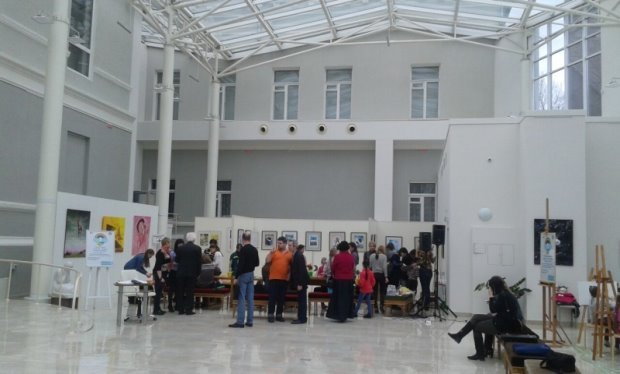 Taras Shevchenko Museum.
Taras Shevchenko Museum.
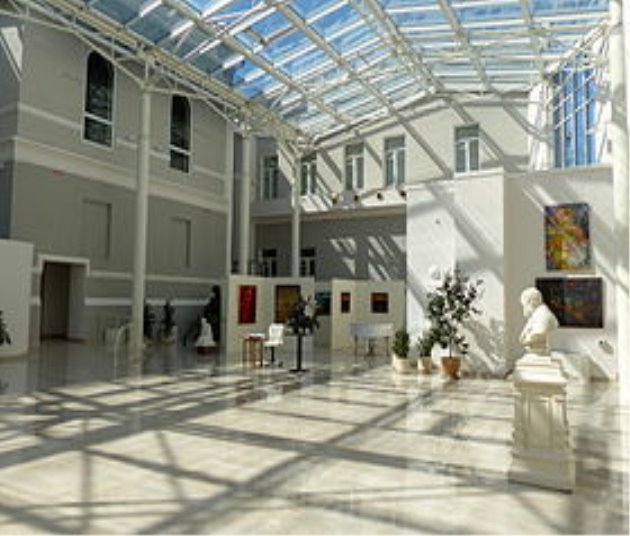
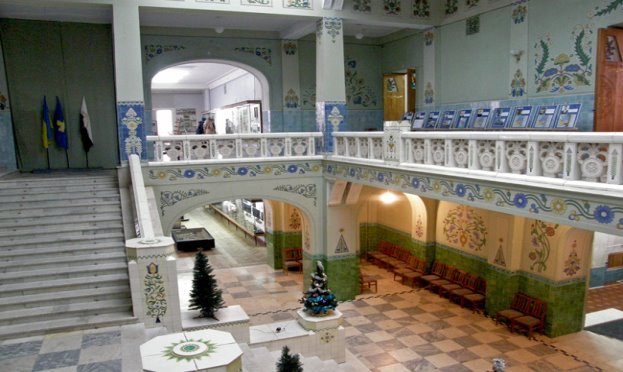
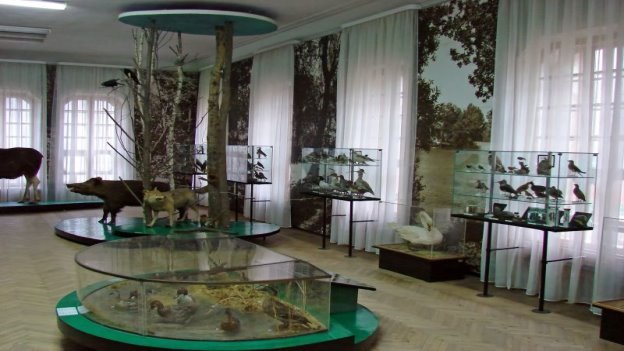 the Poltava Museum of Local History
the Poltava Museum of Local History


про публікацію авторської розробки
Додати розробку
